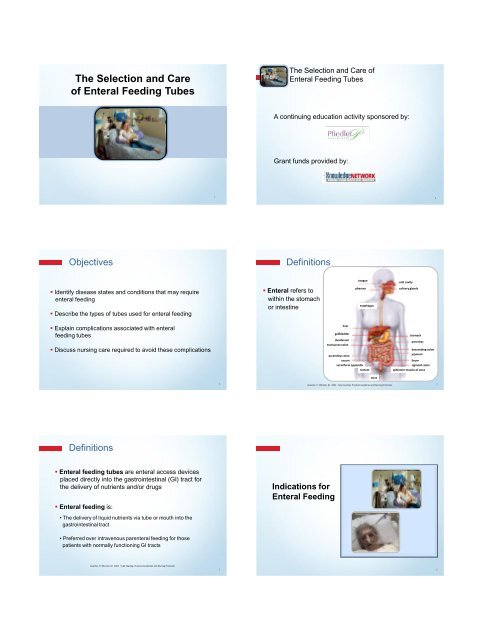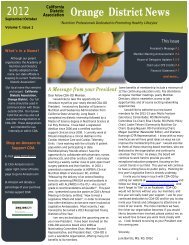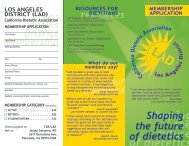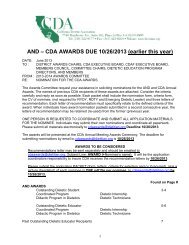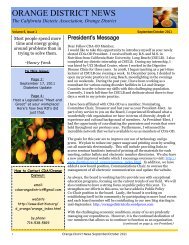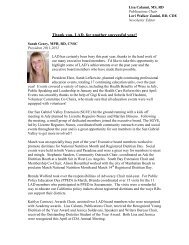The Selection and Care of Enteral Feeding Tubes
The Selection and Care of Enteral Feeding Tubes
The Selection and Care of Enteral Feeding Tubes
Create successful ePaper yourself
Turn your PDF publications into a flip-book with our unique Google optimized e-Paper software.
<strong>The</strong> <strong>Selection</strong> <strong>and</strong> <strong>Care</strong><br />
<strong>of</strong> <strong>Enteral</strong> <strong>Feeding</strong> <strong>Tubes</strong><br />
Objectives<br />
Identify disease states <strong>and</strong> conditions that may require<br />
enteral feeding<br />
Describe the types <strong>of</strong> tubes used for enteral feeding<br />
Explain complications associated with enteral<br />
feeding tubes<br />
Discuss nursing care required to avoid these complications<br />
Definitions<br />
<strong>Enteral</strong> feeding tubes are enteral access devices<br />
placed directly into the gastrointestinal (GI) tract for<br />
the delivery <strong>of</strong> nutrients <strong>and</strong>/or drugs<br />
<strong>Enteral</strong> feeding is:<br />
• <strong>The</strong> delivery <strong>of</strong> liquid nutrients via tube or mouth into the<br />
gastrointestinal tract<br />
• Preferred over intravenous parenteral feeding for those<br />
patients with normally functioning GI tracts<br />
Guenter, P, Silkroski, M. 2001. Tube <strong>Feeding</strong>: Practical Guidelines <strong>and</strong> Nursing Protocols.<br />
<strong>The</strong> <strong>Selection</strong> <strong>and</strong> <strong>Care</strong> <strong>of</strong><br />
<strong>Enteral</strong> <strong>Feeding</strong> <strong>Tubes</strong><br />
A continuing education activity sponsored by:<br />
Grant funds provided by:<br />
1 2<br />
3<br />
5<br />
Definitions<br />
<strong>Enteral</strong> refers to<br />
within the stomach<br />
or intestine<br />
Indications for<br />
<strong>Enteral</strong> <strong>Feeding</strong><br />
liver<br />
gallbladder<br />
duodenum<br />
transverse colon<br />
tongue<br />
pharynx<br />
esophagus<br />
ascending colon<br />
cecum<br />
vermiform appendix<br />
rectum<br />
anus<br />
Guenter, P, Silkroski, M. 2001. Tube <strong>Feeding</strong>: Practical Guidelines <strong>and</strong> Nursing Protocols.<br />
oral cavity<br />
salivary gl<strong>and</strong>s<br />
stomach<br />
pancreas<br />
descending colon<br />
jejunum<br />
ileum<br />
sigmoid colon<br />
sphincter muscle <strong>of</strong> anus<br />
4<br />
6
Indications for <strong>Enteral</strong> <strong>Feeding</strong><br />
<strong>Enteral</strong> feeding is indicated for patients who<br />
have a functional GI tract but they:<br />
• will not, should not, or cannot eat<br />
• are/will become malnourished<br />
• are unable to maintain optimal nutritional status via<br />
oral feedings<br />
Guenter, P. 2001. Chapter 2 <strong>Enteral</strong> Nutrition Basics, Tube <strong>Feeding</strong>: Practical Guidelines <strong>and</strong> Nursing Protocols 7<br />
Disease States/Conditions that May<br />
Require <strong>Enteral</strong> <strong>Feeding</strong> Include …<br />
Disease/Condition Examples<br />
Hypermetabolism major surgery, sepsis, trauma<br />
Neurological Disease stroke, multiple sclerosis, head injury<br />
CREST. April 2004. Guidelines for the Management <strong>of</strong> <strong>Enteral</strong> Tube <strong>Feeding</strong> in Adults.<br />
Disease States/Conditions that May<br />
Require <strong>Enteral</strong> <strong>Feeding</strong> Include …<br />
Disease/Condition Examples<br />
Hypermetabolism major surgery, sepsis, trauma<br />
Neurological Disease stroke, multiple sclerosis, head injury<br />
Gastrointestinal Disease<br />
esophageal obstruction, bowel disease,<br />
pancreatic insufficiency, gastroparesis<br />
Cancer chemo or radiotherapy, surgery<br />
Psychiatric Disease anorexia nervosa, severe depression<br />
Organ System Failure respiratory, renal, cardiac, hepatic<br />
Learning Disability cerebral palsy, Rett syndrome<br />
Failure to Thrive Cystic fibrosis, celiac disease, Crohn’s Disease<br />
CREST. April 2004. Guidelines for the Management <strong>of</strong> <strong>Enteral</strong> Tube <strong>Feeding</strong> in Adults.<br />
9<br />
11<br />
Indications for <strong>Enteral</strong> <strong>Feeding</strong><br />
If oral dietary intake remains<br />
compromised or<br />
is contraindicated for more<br />
than 5-7 days, enteral<br />
feeding may be necessary<br />
CREST. April 2004. Guidelines for the Management <strong>of</strong> <strong>Enteral</strong> Tube <strong>Feeding</strong> in Adults.<br />
Disease States/Conditions that May<br />
Require <strong>Enteral</strong> <strong>Feeding</strong> Include …<br />
Disease/Condition Examples<br />
Hypermetabolism major surgery, sepsis, trauma<br />
Neurological Disease stroke, multiple sclerosis, head injury<br />
Gastrointestinal Disease<br />
esophageal obstruction, bowel disease,<br />
pancreatic insufficiency, gastroparesis<br />
Cancer chemo or radiotherapy, surgery<br />
Psychiatric Disease anorexia nervosa, severe depression<br />
<strong>Enteral</strong> <strong>Feeding</strong><br />
Tube Types<br />
CREST. April 2004. Guidelines for the Management <strong>of</strong> <strong>Enteral</strong> Tube <strong>Feeding</strong> in Adults.<br />
8<br />
10<br />
12
Evolution <strong>of</strong> <strong>Feeding</strong> <strong>Tubes</strong><br />
Nasogastric tubes<br />
Modified drainage<br />
Levine tubes<br />
Foley catheters<br />
Current balloon retained<br />
Oroenteric <strong>Feeding</strong> <strong>Tubes</strong><br />
Orogastric<br />
Oroduodenal<br />
Orojejunal<br />
May be placed via oral route<br />
CREST. April 2004. Guidelines for the Management <strong>of</strong> <strong>Enteral</strong> Tube <strong>Feeding</strong> in Adults.<br />
Enterostomy <strong>Tubes</strong><br />
Two categories:<br />
• Gastrostomy tubes<br />
• Jejunostomy tubes<br />
Method <strong>of</strong> placement:<br />
• Open surgical<br />
• Laparoscopic<br />
• Endoscopic<br />
• Radiologic<br />
Orogastric<br />
feeding tube<br />
Orojejunal<br />
feeding tube<br />
Guenter, P. 2001. Chapter 3. <strong>Enteral</strong> <strong>Feeding</strong> Access Devices, Tube <strong>Feeding</strong>: Practical Guidelines <strong>and</strong> Nursing Protocols; Bowers, S. Dec 2000.<br />
All About tubes, Nursing 30.<br />
13<br />
15<br />
17<br />
Nasoenteric <strong>Feeding</strong> <strong>Tubes</strong><br />
Nasogastric<br />
Nasoduodenal<br />
Nasojejunal<br />
CREST. April 2004. Guidelines for the Management <strong>of</strong> <strong>Enteral</strong> Tube <strong>Feeding</strong> in Adults.<br />
Nasoenteric <strong>Tubes</strong><br />
Short-term (< 4 weeks)<br />
Most common<br />
Easiest to place<br />
Least expensive<br />
Placement<br />
Method<br />
Surgical<br />
Insertion<br />
Laparoscopic<br />
Endoscopic<br />
Guenter, P. 2001. Chapter 3 <strong>Enteral</strong> <strong>Feeding</strong> Access Devices, Tube <strong>Feeding</strong>: Practical Guidelines <strong>and</strong> Nursing Protocols<br />
Enterostomy <strong>Tubes</strong><br />
Remarks<br />
• General anesthesia required; <strong>of</strong>ten as a secondary<br />
procedure during abdominal surgery for another condition<br />
• May have ileus 24 hours post-op; Gastric decompression<br />
usually ordered<br />
• Observe for post-surgical complications<br />
• Monitored conscious sedation; deep sedation or general<br />
anesthesia may be required for some patients<br />
• Less invasive than surgical<br />
• Local anesthesia <strong>and</strong> conscious sedation; requires<br />
monitoring<br />
• Popular placement method<br />
Guenter, P. 2001. Chapter 3. <strong>Enteral</strong> <strong>Feeding</strong> Access Devices, Tube <strong>Feeding</strong>: Practical Guidelines <strong>and</strong> Nursing Protocols; Bowers, S. Dec 2000.<br />
All About tubes, Nursing 30.; Duh, Q. et al. 1999 Laparoscopic Gastrostomy <strong>and</strong> Jejunostomy: Safety <strong>and</strong> cost with Local vs. General Anesthesia.<br />
ARCH SURG 134:151-6.<br />
14<br />
16<br />
18
Percutaneous Endoscopic<br />
Gastrostomy (PEG)<br />
Gastrostomy <strong>Tubes</strong><br />
PEG Tube<br />
Examples <strong>of</strong> balloon <strong>and</strong> pigtail retained gastrostomy tubes<br />
Balloon Retention – recessed tip<br />
Jejunostomy <strong>Tubes</strong><br />
St<strong>and</strong>ard<br />
Pigtail Retention (modified drainage)<br />
Does not have an external retention mechanism<br />
Low pr<strong>of</strong>ile<br />
19<br />
21<br />
23<br />
Placement<br />
Method<br />
Surgical<br />
Insertion<br />
Laparoscopic<br />
Endoscopic<br />
Radiologic<br />
Enterostomy <strong>Tubes</strong><br />
Remarks<br />
• General anesthesia required; <strong>of</strong>ten as a secondary<br />
procedure during abdominal surgery for another condition<br />
• May have ileus 24 hours post-op; Gastric decompression usually<br />
ordered<br />
• Observe for post-surgical complications<br />
• Monitored conscious sedation; deep sedation or general<br />
anesthesia may be required for some patients<br />
• Less invasive than surgical<br />
• Local anesthesia <strong>and</strong> conscious sedation; requires monitoring<br />
• Popular placement method<br />
• Monitored conscious sedation; does not typically require general<br />
anesthesia<br />
• Least invasive; lower costs <strong>and</strong> risks than other methods<br />
Guenter, P. 2001. Chapter 3. <strong>Enteral</strong> <strong>Feeding</strong> Access Devices, Tube <strong>Feeding</strong>: Practical Guidelines <strong>and</strong> Nursing Protocols; Bowers, S. Dec 2000.<br />
All About tubes, Nursing 30.; Duh, Q. et al. 1999 Laparoscopic Gastrostomy <strong>and</strong> Jejunostomy: Safety <strong>and</strong> cost with Local vs. General Anesthesia.<br />
ARCH SURG 134:151-6.<br />
Low-Pr<strong>of</strong>ile Gastrostomy Devices (LPGDs)<br />
Alternative to traditional gastrostomy or PEG tube<br />
Anchored in the stomach <strong>and</strong> protrudes just above skin<br />
More acceptable cosmetically; affords greater independence<br />
Difficult to dislodge; good choice for children/confused adults<br />
Non-balloon retained Balloon retained<br />
Gastro-Jejunal <strong>Tubes</strong><br />
St<strong>and</strong>ard<br />
Low pr<strong>of</strong>ile<br />
20<br />
22<br />
24
<strong>Enteral</strong> <strong>Feeding</strong> Tube Decision Tree<br />
Factors to consider prior to selecting an access<br />
route <strong>and</strong> device for enteral feeding include:<br />
• <strong>The</strong> patient’s prognosis<br />
• <strong>The</strong> patient’s medical condition<br />
• Availability <strong>of</strong> local technical expertise<br />
• Potential complications <strong>of</strong> tube insertion<br />
• Length <strong>of</strong> time that the tube feeding will be needed<br />
CREST. April 2004. Guidelines for the Management <strong>of</strong> <strong>Enteral</strong> Tube <strong>Feeding</strong> in Adults.<br />
<strong>Enteral</strong> <strong>Feeding</strong> Tube Decision Tree<br />
Short Term<br />
Less than 3 to 4 weeks<br />
Nasoenteric Tube<br />
<strong>Enteral</strong> Nutrition Needed<br />
Long Term<br />
Greater than 3 to 4 weeks<br />
Guenter, P., Silkroski, M. 2001. <strong>Enteral</strong> <strong>Feeding</strong> Access Devices. Tube <strong>Feeding</strong> Practical Guidelines <strong>and</strong> Nursing Protocols.<br />
<strong>Enteral</strong> <strong>Feeding</strong> Tube Decision Tree<br />
Short Term<br />
Less than 3 to 4 weeks<br />
No Aspiration Risk or<br />
Gastric Problems<br />
Nasogastric Tube<br />
Nasoenteric Tube<br />
<strong>Enteral</strong> Nutrition Needed<br />
Aspiration Risk or<br />
Delayed Gastric<br />
Emptying<br />
Nasoduodenal or<br />
Nasojejunal Tube<br />
Long Term<br />
Greater than 3 to 4 weeks<br />
Guenter, P., Silkroski, M. 2001. <strong>Enteral</strong> <strong>Feeding</strong> Access Devices. Tube <strong>Feeding</strong> Practical Guidelines <strong>and</strong> Nursing Protocols.<br />
25<br />
27<br />
29<br />
<strong>Enteral</strong> <strong>Feeding</strong> Tube Decision Tree<br />
Short Term<br />
Less than 3 to 4 weeks<br />
<strong>Enteral</strong> Nutrition Needed<br />
Long Term<br />
Greater than 3 to 4 weeks<br />
Guenter, P., Silkroski, M. 2001. <strong>Enteral</strong> <strong>Feeding</strong> Access Devices. Tube <strong>Feeding</strong> Practical Guidelines <strong>and</strong> Nursing Protocols.<br />
No Aspiration Risk or<br />
Gastric Problems<br />
Nasogastric Tube<br />
<strong>Enteral</strong> <strong>Feeding</strong> Tube Decision Tree<br />
Short Term<br />
Less than 3 to 4 weeks<br />
Nasoenteric Tube<br />
<strong>Enteral</strong> Nutrition Needed<br />
Long Term<br />
Greater than 3 to 4 weeks<br />
Guenter, P., Silkroski, M. 2001. <strong>Enteral</strong> <strong>Feeding</strong> Access Devices. Tube <strong>Feeding</strong> Practical Guidelines <strong>and</strong> Nursing Protocols.<br />
<strong>Enteral</strong> <strong>Feeding</strong> Tube Decision Tree<br />
Short Term<br />
Less than 3 to 4 weeks<br />
No Aspiration Risk or<br />
Gastric Problems<br />
Nasogastric Tube<br />
Nasoenteric Tube<br />
<strong>Enteral</strong> Nutrition Needed<br />
Aspiration Risk or<br />
Delayed Gastric<br />
Emptying<br />
Nasoduodenal or<br />
Nasojejunal Tube<br />
Long Term<br />
Greater than 3 to 4 weeks<br />
No Aspiration Risk<br />
or Gastric Problems<br />
Gastrostomy Tube<br />
Enterostomy Tube<br />
Guenter, P., Silkroski, M. 2001. <strong>Enteral</strong> <strong>Feeding</strong> Access Devices. Tube <strong>Feeding</strong> Practical Guidelines <strong>and</strong> Nursing Protocols.<br />
26<br />
28<br />
30
<strong>Enteral</strong> <strong>Feeding</strong> Tube Decision Tree<br />
Short Term<br />
Less than 3 to 4 weeks<br />
No Aspiration Risk or<br />
Gastric Problems<br />
Nasogastric Tube<br />
<strong>Enteral</strong> Nutrition Needed<br />
Long Term<br />
Greater than 3 to 4 weeks<br />
Nasoenteric Tube Enterostomy Tube<br />
Aspiration Risk or<br />
Delayed Gastric<br />
Emptying<br />
Nasoduodenal or<br />
Nasojejunal Tube<br />
No Aspiration Risk<br />
or Gastric Problems<br />
Gastrostomy Tube<br />
Guenter, P., Silkroski, M. 2001. <strong>Enteral</strong> <strong>Feeding</strong> Access Devices. Tube <strong>Feeding</strong> Practical Guidelines <strong>and</strong> Nursing Protocols.<br />
Aspiration Risk or Delayed<br />
Gastric Emptying [patient<br />
condition dependent ]<br />
Jejunostomy or<br />
Combined<br />
Gastrostomy-<br />
Jejunostomy<br />
Nasoenteric Tube Complications<br />
Sinusitis<br />
Epistaxis<br />
Dysphasia<br />
Dislodgement<br />
Tube occlusion<br />
Pulmonary aspiration<br />
Nasopharyngeal discomfort<br />
Erosion <strong>of</strong> the nasal septum<br />
Migration <strong>and</strong> displacement<br />
Iyer, K.R., Crawley, T.C. Complications <strong>of</strong> <strong>Enteral</strong> Access. Gastrointestinal Endoscopy Clinics <strong>of</strong> North America, 17 (2007) 717-729.<br />
Enterostomy Tube Complications<br />
Infection<br />
Pressure necrosis/ulcers<br />
Skin irritation/breakdown<br />
Excessive granulation tissue<br />
Peritubular allergic reactions<br />
Tube deterioration<br />
Tube occlusion<br />
Tube displacement<br />
Guenter, P. tube Chap 7. 2001. tube <strong>Feeding</strong>: Practical Guidelines <strong>and</strong> Nursing Protocols. CREST. April 2004. Guidelines for the Management <strong>of</strong> <strong>Enteral</strong> Tube <strong>Feeding</strong> In Adults.<br />
31<br />
33<br />
35<br />
Complications<br />
Associated with<br />
<strong>Enteral</strong> <strong>Feeding</strong><br />
<strong>Tubes</strong><br />
Nasoenteric Tube Complications<br />
Nasoenteric feeding<br />
tubes should NOT be<br />
used for periods<br />
longer than 4 weeks.<br />
O’Keefe, S.J.D.Na.Rev.Gastroenterol.Hepatol,6,210 (2009)<br />
<strong>The</strong> Joint Commission<br />
Sentinel Event Alert: Issue 36 – April 3, 2006<br />
“Tubing misconnections – a persistent <strong>and</strong> potentially deadly occurrence”<br />
Reported cases to Joint Commission:<br />
eight deaths <strong>and</strong> one instance <strong>of</strong> permanent<br />
loss <strong>of</strong> function; 7 adults <strong>and</strong> 2 infants<br />
“tube feeding formula is accidentally connected to intravenous<br />
or other lines or catheters for which it was not intended”<br />
<strong>The</strong> Joint Commission Sentinel Event Alert, Issue 36, April 3, 2006.<br />
32<br />
34<br />
36
Caution!<br />
Avoid placement <strong>of</strong> Foley<br />
catheters or tubes not intended for<br />
use as enteral feeding devices<br />
Why?<br />
Tube migration, occlusion, skin<br />
irritation <strong>and</strong> allergies, excess<br />
tubing on outside <strong>of</strong> body, tube<br />
misconnections<br />
ASPEN. 2009 Jan 26. <strong>Enteral</strong> Nutrition Practice Recommendations. J Parenter <strong>Enteral</strong> Nutr OnlineFirst,doi:10.1177/0148607108330314. Accessed 3/24/2009. 37<br />
<strong>Care</strong> <strong>of</strong> <strong>Enteral</strong> <strong>Feeding</strong> <strong>Tubes</strong><br />
Pulmonary Aspiration:<br />
Evaluate all enterally fed patients for risk <strong>of</strong> aspiration.<br />
Assure the feeding tube is in the proper position before<br />
initiating feedings.<br />
Keep head <strong>of</strong> bed elevated at 30 - 45 at all times during<br />
the administration <strong>of</strong> enteral feedings.<br />
ASPEN. 2009 Jan 26. <strong>Enteral</strong> Nutrition Practice Recommendations. J Parenter <strong>Enteral</strong> Nutr OnlineFirst, doi:10.1177/0148607108330314. Accessed 3/24/2009.<br />
<strong>Care</strong> <strong>of</strong> Nasoenteric <strong>Tubes</strong><br />
Tube placement should be checked:<br />
• every 8 hours during continuous feedings<br />
• before each intermittent feeding<br />
Change fixator device or tape as<br />
needed <strong>and</strong> at least every 3 to 5 days<br />
Inspect the nares, mouth, <strong>and</strong> pharynx daily for skin<br />
irritation, ulceration, pressure necrosis <strong>and</strong> lesions<br />
Guenter, P. 2001. Chapter 4: Nursing <strong>Care</strong> <strong>of</strong> Patients with <strong>Enteral</strong> <strong>Feeding</strong> Devices. Tube <strong>Feeding</strong> Practical Guidelines <strong>and</strong> Nursing Protocols. ASPEN.<br />
39<br />
41<br />
<strong>Care</strong> <strong>of</strong> <strong>Enteral</strong><br />
<strong>Feeding</strong> <strong>Tubes</strong><br />
St<strong>and</strong>ard policies <strong>and</strong> protocols<br />
should be developed <strong>and</strong><br />
followed to enable staff to provide<br />
consistent, safe, quality care<br />
<strong>Care</strong> <strong>of</strong> Nasoenteric <strong>Tubes</strong><br />
Regularly assess <strong>and</strong> monitor to:<br />
• Ensure correct placement<br />
• Protect mucosal surfaces<br />
• Avoid complications such as skin<br />
breakdown or infection, tube clogging<br />
If problems arise, early intervention<br />
is key to maintaining enteral access<br />
<strong>Enteral</strong> Nutrition: Procedures <strong>and</strong> Guidelines<br />
<strong>Care</strong> <strong>of</strong> Nasoenteric <strong>Tubes</strong><br />
Maintain good oral hygiene<br />
• Follow facility policy for oral<br />
care <strong>and</strong> for flushing the tube<br />
Daily assessment<br />
Brush teeth (<strong>and</strong> tongue)<br />
Frequent rinsing<br />
Suction (if indicated)<br />
Guenter, P. 2001. Chapter 4: Nursing <strong>Care</strong> <strong>of</strong> Patients with <strong>Enteral</strong> <strong>Feeding</strong> Devices. Tube <strong>Feeding</strong> Practical Guidelines <strong>and</strong> Nursing Protocols. ASPEN.<br />
38<br />
40<br />
42
<strong>Care</strong> <strong>of</strong> Enterostomy <strong>Tubes</strong><br />
Regularly assess <strong>and</strong> monitor to:<br />
• Ensure correct placement<br />
• Protect skin at the exit site<br />
• Maintain tube patency <strong>and</strong> integrity<br />
If problems arise, early intervention<br />
is key to maintaining enteral access<br />
<strong>Enteral</strong> Nutrition: Procedures <strong>and</strong> Guidelines<br />
Routine Stoma Site <strong>Care</strong><br />
Strict adherence to infection control<br />
protocols<br />
Daily inspection for irritation or infection<br />
Cleanse skin per facility policy<br />
Inspect gastrostomy tube <strong>and</strong> rotate<br />
the bumper/bolster to ensure proper fit<br />
Do not rotate jejunal tubes<br />
<strong>Care</strong> <strong>of</strong> Enterostomy <strong>Tubes</strong><br />
Infection (i.e. bacterial, fungal):<br />
Practice appropriate h<strong>and</strong> hygiene<br />
Assess skin daily for signs <strong>of</strong> irritation or infection<br />
Document findings<br />
Keep dressing dry<br />
Protect skin from moisture<br />
Wound Ostomy <strong>and</strong> Continence Nurses Society, Management <strong>of</strong> Gastrostomy Tube Complications for Pediatric <strong>and</strong> Adult Patient.<br />
43<br />
45<br />
47<br />
<strong>Care</strong> <strong>of</strong> Enterostomy <strong>Tubes</strong><br />
Tube displacement/migration:<br />
Secure the device<br />
Check for placement, stabilization <strong>and</strong> fit daily <strong>and</strong> prn<br />
Balloon retention devices should have the internal<br />
balloon checked for proper inflation every 7 to 10 days<br />
Guenter, P. 2001. Chap 4. Tube <strong>Feeding</strong>: Practical guidelines <strong>and</strong> Nursing Protocols..;<br />
<strong>Care</strong> <strong>of</strong> Enterostomy <strong>Tubes</strong><br />
Skin Irritation/Allergy:<br />
Inspect skin around tube site daily for signs <strong>of</strong> skin<br />
breakdown, infection, tenderness or excoriation; if<br />
present, assess <strong>and</strong> address cause<br />
Cleanse skin with warm water <strong>and</strong> mild soap; avoid<br />
routine use <strong>of</strong> hydrogen peroxide<br />
Assess for tube migration <strong>and</strong>/or inappropriate inflation<br />
<strong>of</strong> balloon (if applicable)<br />
Bowers, S. All About <strong>Tubes</strong>: Your Guide to <strong>Enteral</strong> <strong>Feeding</strong> Devices. Nursing2000.<br />
Wound Ostomy <strong>and</strong> Continence Nurses Society, Management <strong>of</strong> Gastrostomy Tube Complications for Pediatric <strong>and</strong> Adult Patient.<br />
<strong>Care</strong> <strong>of</strong> Enterostomy <strong>Tubes</strong><br />
Hypergranulation Tissue:<br />
Restrict the use <strong>of</strong> hydrogen peroxide<br />
Prevent:<br />
• excessive tube movement<br />
• excessive moisture<br />
• constant exposure to drainage<br />
Wound Ostomy <strong>and</strong> Continence Nurses Society, Management <strong>of</strong> Gastrostomy Tube Complications for Pediatric <strong>and</strong> Adult Patient.<br />
44<br />
46<br />
48
<strong>Care</strong> <strong>of</strong> Enterostomy <strong>Tubes</strong><br />
Injury to the Patient (e.g. pressure ulcers, necrosis):<br />
Ensure internal bolster contains proper fill volume<br />
(for balloon-retained devices)<br />
Ensure external bolster/stabilizer rests comfortably<br />
against the skin without excess tension<br />
Rotate bumper daily<br />
Avoid bulky dressings under the external bumper<br />
Do not rotate jejunal tubes<br />
Wound Ostomy <strong>and</strong> Continence Nurses Society. Management <strong>of</strong> Gastrostomy Tube Complications for the Pediatric <strong>and</strong> Adult Patient.<br />
<strong>Care</strong> <strong>of</strong> Enterostomy <strong>Tubes</strong><br />
Tube Occlusion <strong>and</strong> Deterioration:<br />
Flush feeding tubes with 30 ml. <strong>of</strong> water:<br />
• every 4 hours during continuous feeding<br />
• before <strong>and</strong> after intermittent feedings in an adult patient<br />
Adhere to protocols that call for proper flushing <strong>of</strong> tubes<br />
before <strong>and</strong> after medication administration<br />
Establish <strong>and</strong> follow flushing protocol for neonatal <strong>and</strong><br />
pediatric patients; fluid restricted patients<br />
Observe for tube for signs <strong>of</strong> deterioration<br />
ASPEN. 2009 Jan 26. <strong>Enteral</strong> Nutrition Practice Recommendations. J Parenter <strong>Enteral</strong> Nutr OnlineFirst, doi:10.1177/0148607108330314. Accessed 3/24/2009.<br />
Keep Informed <strong>of</strong><br />
New Developments!<br />
“<strong>The</strong> field <strong>of</strong> interventional tube feeding is<br />
exp<strong>and</strong>ing rapidly, which has led to a pr<strong>of</strong>usion <strong>of</strong><br />
enteral access techniques, specialized feeding<br />
tubes, <strong>and</strong> liquid formula diets being developed.”<br />
O’Keefe, S.J.D. Nat.Rev.Gastroenterol.Hepatol.6, 207-215 (2009)<br />
49<br />
51<br />
53<br />
<strong>Care</strong> <strong>of</strong> Enterostomy <strong>Tubes</strong><br />
Leakage around the Tube:<br />
Stabilize the tube<br />
Check for appropriate balloon inflation<br />
Note manufacturer’s mark on the tube to assess for<br />
migration<br />
Verify leakage has stopped<br />
If uncontrolled, considerations include replacement,<br />
barrier ointment, skin sealant, absorbent dressings<br />
Wound Ostomy <strong>and</strong> Continence Nurses Society. Management <strong>of</strong> Gastrostomy Tube Complications for the Pediatric <strong>and</strong> Adult Patient.<br />
50<br />
Summary<br />
<strong>The</strong> placement <strong>of</strong> enteral feeding tubes is required in<br />
certain patient conditions/disease states<br />
Different tube types are required depending on placement<br />
requirements<br />
<strong>Enteral</strong> feeding tubes are associated with complications<br />
Establish a protocol for care <strong>and</strong> consistently perform best<br />
practice when caring for patients with enteral feeding tubes<br />
<strong>The</strong> <strong>Selection</strong> <strong>and</strong> <strong>Care</strong> <strong>of</strong> <strong>Enteral</strong> <strong>Feeding</strong> <strong>Tubes</strong><br />
• Conditions Requiring <strong>Enteral</strong> <strong>Feeding</strong><br />
• Types <strong>of</strong> <strong>Feeding</strong> <strong>Tubes</strong><br />
• Complications<br />
• Nursing <strong>Care</strong><br />
Thank You!<br />
© 2009 Kimberly-Clark Worldwide, Inc. All rights reserved. <strong>The</strong> material in this presentation is proprietary<br />
to Kimberly-Clark <strong>and</strong> may not be reproduced or used without written permission.<br />
52<br />
54


